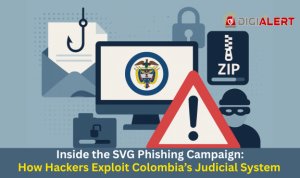Displaying items by tag: CyberDefense
New Zero-Day Alert: APT28 Exploits Outlook Vulnerability in Global Cyber Espionage Campaign
In today’s hyper-connected world, email remains the lifeblood of business communications. From sensitive government directives to financial transactions and cross-border policy coordination, Outlook and similar platforms serve as the arteries of modern enterprises. But when the very tools designed to connect us become the vectors of compromise, the stakes could not be higher.
New UNC6384 Campaign Deploys PlugX via Captive Portal Attacks – Is Your Network Secure?
When you connect to a public Wi-Fi network, what’s the first thing you see?
Usually, a captive portal that login or “Agree to Terms & Conditions” page you click before getting access. For most people, it’s a routine step. But what if that portal wasn’t a harmless gateway, but instead a weaponized tool used by cybercriminals to infect your device?
That’s exactly what’s happening in a sophisticated cyber campaign launched by UNC6384, a threat actor now under global watch. By exploiting captive portals, UNC6384 is distributing the notorious PlugX malware, a remote access trojan capable of data theft, persistence, and further compromise.
Did you know that over 60% of malware infections begin with a simple click?
The ClickFix malware campaign is a sobering reminder that cyberattacks no longer require sophisticated exploits or deep infiltration tactics—just one careless moment is all it takes. By exploiting trust in legitimate software updates, ClickFix is wreaking havoc across industries. As ransomware attacks have surged by 72% over the past year alone, this particular threat is putting businesses at risk like never before.
CL STA 0969 Malware: The Silent Threat Targeting Global Networks — Is Your Organization Prepared?
The Age of Silent Cyberattacks
In today’s interconnected digital landscape, cyber threats have grown more sophisticated, stealthier, and devastatingly effective. Among the most alarming developments in 2025 is the emergence of a covert malware strain known as CL STA 0969—a silent yet highly potent weapon in the hands of threat actors.
In a rare but significant victory for the cybersecurity community, a free decryptor has been released for the notorious FunkSec ransomware. This tool now enables affected organizations to recover their encrypted data without paying ransom, marking the end of a campaign that has so far claimed 172 known victims across the United States, India, and Brazil.
Imagine your website crashing in the middle of your biggest sales day. Now imagine that crash was no accident – it was a calculated, high-volume DDoS attack, flooding your servers with traffic and leaving your business offline, helpless, and hemorrhaging revenue.
Did you know that 68% of cyberattacks now involve fileless or evasion techniques?
The recent resurgence of the leaked Shellter tool in hacker arsenals is a wake-up call: legacy security systems are being outmaneuvered by sophisticated evasion tactics. It’s time we asked the hard question — is your organization truly prepared?
Cybercriminal groups are no longer isolated, amateur hackers operating from basements. Today’s threat actors are well-funded, organized, and capable of breaching even the most sophisticated networks. The FBI’s recent alert about Scattered Spiders is a clear indication that cyber threats are evolving, growing bolder, and becoming far more dangerous in 2024.
In a decisive move against state-sponsored cybercrime, the U.S. Department of Justice recently seized $7.74 million worth of cryptocurrency linked to North Korea’s elite hacking syndicate, the Lazarus Group. While the amount may seem small compared to global cybercrime losses, it represents a symbolic and tactical win in a growing cyberwar that’s threatening businesses worldwide.
WordPress Sites Under Attack: How Hackers Are Exploiting Vulnerabilities and What You Can Do
With over 43% of all websites on the internet built using WordPress, it’s no surprise that the platform is a favorite target for cybercriminals. While its flexibility, massive plugin ecosystem, and ease of use make it a go-to CMS for businesses and developers, its popularity also presents an enticing opportunity for hackers.
















